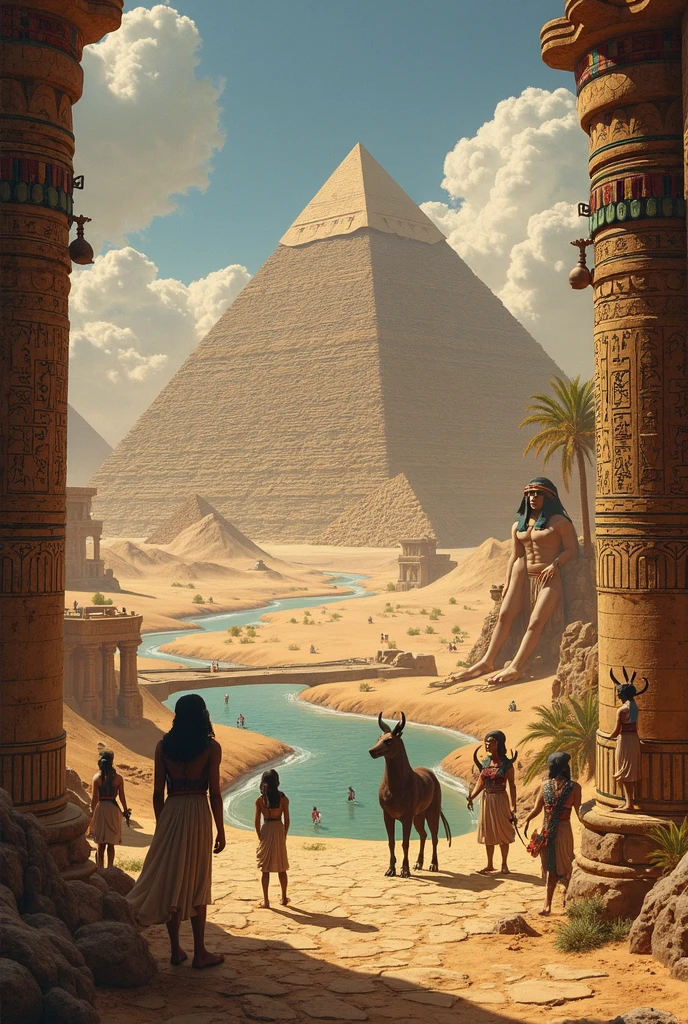Native American Mythology: The Role of Coyote and Other Spirits
Native American mythology is a rich tapestry of stories, beliefs, and traditions that have been passed down through generations. Among the most fascinating figures is Coyote, the Trickster, who plays a central role in many tribal narratives. These myths often explore themes of creation, morality, and the relationship between humans and nature. In this article, we delve into the significance of Coyote, the Buffalo, the Grandfather spirits, and the broader world of Native American cosmology.
The Trickster Coyote in Native American Lore
The Coyote is one of the most prominent figures in Native American mythology, appearing in the stories of numerous tribes, including the Navajo, Lakota, and Nez Perce. As a Trickster, Coyote embodies both wisdom and foolishness, often teaching important lessons through his misadventures.
- Coyote as a creator: In some myths, he helps shape the world.
- Coyote as a deceiver: His tricks sometimes backfire, leading to chaos.
- Coyote as a teacher: His failures often serve as moral lessons.
For example, in a Navajo story, Coyote steals fire from the gods to give to humans, demonstrating his dual role as both hero and troublemaker. His unpredictable nature makes him a beloved yet cautionary figure.
Key Coyote Myths Across Tribes
| Tribe | Myth | Lesson |
|---|---|---|
| Navajo | Coyote steals fire | Resourcefulness and consequences |
| Lakota | Coyote tricks the Buffalo | Respect for nature |
| Nez Perce | Coyote and the creation of rivers | Balance in the world |
The Sacred Buffalo in Native American Culture
The Buffalo holds a sacred place in many Native American traditions, symbolizing abundance, strength, and survival. Tribes such as the Lakota and Cheyenne revered the Buffalo as a gift from the Grandfather spirits, essential for sustenance and spiritual practices.
Key aspects of Buffalo mythology include:
- The White Buffalo Woman, a sacred figure in Lakota lore.
- Buffalo dances, performed to honor the spirit of the animal.
- Stories of the Buffalo as a provider and protector.
For more on the spiritual significance of the Buffalo, visit Native Languages.
Grandfather Spirits and Creation Stories
In many Native American traditions, the Grandfather spirits are revered as ancient, wise beings who oversee the natural world. These spirits are often invoked in rituals and creation stories, serving as intermediaries between humans and the divine.
Common themes involving Grandfather spirits include:
- Guidance in times of need.
- Teachings about respect for the earth.
- Stories of how they shaped the land and its creatures.
Creation Myths Featuring Grandfather Spirits
| Tribe | Creation Story | Role of Grandfather |
|---|---|---|
| Hopi | Emergence from the underworld | Guides the people to the surface |
| Cherokee | The Great Buzzard shapes the land | Oversees the balance of nature |
| Iroquois | Turtle Island creation | Wisdom keeper of the earth |
The Interconnected World of Spirits
Native American mythology emphasizes the interconnectedness of all beings, from the Coyote to the Buffalo and the Grandfather spirits. These stories teach respect for nature, the importance of balance, and the wisdom of ancestral knowledge.
For further reading on Native American cosmology, explore Encyclopedia Britannica or Smithsonian NMAI.
Descubre más artículos fascinantes sobre mitología y cultura en nuestra web y síguenos en facebook.com/zatiandrops.
The Thunderbird: A Symbol of Power and Protection
Another towering figure in Native American mythology is the Thunderbird, a colossal bird of immense power revered by tribes across North America. Often depicted with lightning in its talons and thunder in its wings, this mythical creature embodies both destruction and renewal. The Thunderbird appears in the lore of the Algonquian, Ojibwe, and Pacific Northwest tribes, each with unique interpretations of its role.
- Thunderbird as a guardian: Protects humans from evil spirits like the underwater serpent, Unktehi (Lakota).
- Thunderbird as a weather controller: Its wingbeats create storms, bringing life-giving rain (Ojibwe).
- Thunderbird as a divine messenger: Delivers wisdom from the Creator (Kwakwaka’wakw).
Thunderbird Myths by Region
| Tribe/Region | Legend | Symbolism |
|---|---|---|
| Pacific Northwest | Thunderbird vs. Whale | Struggle between sky and sea |
| Plains (Lakota) | Thunderbird battles Unktehi | Good vs. evil |
| Great Lakes (Ojibwe) | Thunderbird brings rain | Renewal and fertility |
Spider Woman: The Weaver of Destiny
In Southwestern tribes like the Hopi and Navajo, Spider Woman (Na’ashjé’ii Asdzáá) is a revered deity associated with creation, wisdom, and fate. She taught humans to weave—both literally and metaphorically—guiding them in crafting textiles and the “web” of life. Her stories emphasize patience, creativity, and interconnectedness.
Key teachings from Spider Woman myths include:
- The Gift of Weaving: She gifted the Navajo the first loom, symbolizing cultural preservation.
- The Web of Life: Her webs connect all beings, illustrating unity (Hopi).
- Protector of Heroes: In some tales, she shields warriors like the Twin War Gods (Diné Bahaneʼ).
The Star People and Celestial Myths
Many tribes, such as the Skidi Pawnee and Cherokee, share stories of the Star People—celestial beings who influenced human origins. The Pawnee, for example, practiced elaborate star ceremonies, believing their ancestors descended from the Pleiades. Similarly, Cherokee myths describe the Star People as teachers who brought knowledge of agriculture and medicine.
Notable Star Myths
- Pleiades (Seven Sisters): Linked to agricultural cycles (Pawnee) and mourning rituals (Cherokee).
- Morning Star: Symbolizes courage and resurrection (Skidi Pawnee).
- Orion’s Belt: Called the “Three Hunters” in Lakota lore, representing eternal pursuit.
Water Spirits and the Underworld
Rivers, lakes, and oceans hold deep spiritual significance, often guarded by beings like the Water Panther (Anishinaabe) or Avanyu (Pueblo). These serpentine spirits control floods, healing waters, and the boundary between worlds. For instance:
- Avanyu: The Tewa Pueblo’s horned serpent brings rain but also warns of droughts.
- Mishipeshu: The Anishinaabe’s underwater lynx protects copper and tests human humility.
Explore the role of water deities at Native-Languages.org.
Transformation Myths: Humans and Animals
Shape-shifting is a recurring theme, blurring the line between humans and animals. The Skinwalker (Navajo Yee Naaldlooshii) and Bear-Walker (Algonquian) are feared figures, while benevolent transformers like the Salmon People (Coastal tribes) symbolize rebirth.
| Figure | Tribe | Significance |
|---|---|---|
| Skinwalker | Navajo | Taboo magic and warnings against greed |
| Salmon People | Haida | Cycles of sacrifice and renewal |
Rituals and Ceremonies Rooted in Myth
Myths live on through ceremonies like the Sun Dance (Lakota) or Potlatch (Kwakwaka’wakw). These rituals reenact cosmic events—for example, the Sun Dance mirrors the Thunderbird’s sacrifice to bring rain, while Potlatch celebrates the Raven’s gift of light (Tlingit).
Descubre más artículos fascinantes sobre mitología y cultura en nuestra web y síguenos en facebook.com/zatiandrops.
The Raven: Bringer of Light and Knowledge
In the Pacific Northwest, the Raven holds a place of honor similar to Coyote in other traditions. Among the Tlingit, Haida, and Kwakwaka’wakw peoples, Raven is a complex figure—both creator and trickster—who brought light to the world. One famous Haida myth tells how Raven stole the sun from a selfish chief and released it into the sky, illuminating the earth for all beings.
- Raven as culture hero: Introduced fire, fresh water, and salmon to humans.
- Raven as shape-shifter: Often transformed into leaves, pebbles, or even people to achieve his goals.
- Raven as boundary-crosser: Moves freely between the spirit and human worlds.
Raven’s Greatest Deeds in Northwest Mythology
| Tribe | Story | Outcome |
|---|---|---|
| Tlingit | Steals fresh water from Petrel | Creates rivers and streams |
| Haida | Releases the sun | Brings daylight to world |
| Kwakwaka’wakw | Steals salmon from Beaver | Provides staple food source |
The Corn Mother: Sustainer of Life
Among agricultural tribes like the Cherokee, Iroquois, and Pueblo peoples, the Corn Mother (Selu in Cherokee) represents the sacred gift of agriculture. According to Cherokee tradition, when Selu was killed by her suspicious sons, corn grew from her body, teaching that death brings life. This myth explains the origin of corn cultivation and the importance of respecting food sources.
Key aspects of Corn Mother mythology:
- The first corn plants grew from her body (Cherokee)
- She taught women the secrets of agriculture (Iroquois)
- Her spirit lives in every cornfield (Pueblo)
Hero Twins: Champions Against Chaos
The Hero Twins appear in various forms across Native American cultures, most notably in Navajo (Monster Slayer and Child-Born-of-Water) and Maya (Hunahpu and Xbalanque) traditions. These twin brothers typically embark on epic journeys to rid the world of monsters and establish order.
- Navajo Twin Warriors: Destroyed monsters like Ye’iitsoh (Giant) and Delgeth (Horned Monster)
- Maya Hero Twins: Outwitted the Lords of Xibalba (Underworld) through ballgame magic
- Iroquois Twins: Flint (destructive) and Sapling (creative) represent cosmic balance
Comparative Hero Twin Myths
| Culture | Twin Names | Major Feat |
|---|---|---|
| Navajo | Monster Slayer/Child-Born-of-Water | Cleansed world of monsters |
| Maya | Hunahpu/Xbalanque | Defeated death gods |
| Iroquois | Flint/Sapling | Shaped the natural world |
Dreamcatchers and Protective Spirits
The Ojibwe legend of the Dreamcatcher originates with Spider Woman (Asibikaashi), who wove magical webs to protect children from bad dreams. This tradition spread to other tribes through trade and intermarriage, becoming one of the most recognizable symbols of Native American spirituality.
Key elements of the Dreamcatcher myth:
- The hoop represents the circle of life
- The web filters dreams—good dreams pass through, bad ones get trapped
- Feathers act as ladders for good dreams to descend
Totem Animals and Clan Systems
Many tribes organize themselves into clans based on totem animals, each with its own origin story and responsibilities. The Northwest Coast tribes are famous for their towering totem poles, which tell these ancestral stories in carved form.
Common clan animals and their meanings:
- Bear Clan (protection, healing)
- Wolf Clan (loyalty, hunting)
- Turtle Clan (wisdom, longevity)
- Thunderbird Clan (spiritual power)
For more on clan systems, visit Native Languages Clan Page.
Ghost Dance and Prophetic Movements
The Ghost Dance of the late 19th century, originating with Paiute prophet Wovoka, drew upon traditional myths of world renewal. Participants believed the dance would bring back buffalo herds and deceased ancestors, creating a paradise on earth. This powerful movement spread rapidly among Plains tribes before being violently suppressed at Wounded Knee.
Mythological elements in the Ghost Dance:
- Vision of the Messiah (return of White Buffalo Woman)
- Promise of earth renewal (similar to creation myths)
- Use of sacred eagle feathers (connection to Thunderbird)
Descubre más artículos fascinantes sobre mitología y cultura en nuestra web y síguenos en facebook.com/zatiandrops.
The Sacred Pipe and Its Mythological Origins
Among the Lakota and other Plains tribes, the Sacred Pipe (Chanunpa) represents one of the most revered spiritual objects, with its origins deeply rooted in mythology. The White Buffalo Calf Woman legend tells how this divine being brought the pipe to the people as a bridge between earth and sky. The pipe’s bowl symbolizes the earth, while its stem represents the connection to the spirit world.
- Seven Sacred Rites: The pipe is central to Lakota ceremonies like the Vision Quest and Sun Dance
- Peacemaking tool: Used to seal agreements between tribes (as seen in Black Elk’s accounts)
- Prayer instrument: Smoke carries prayers to the Creator
Key Pipe Myths Across Tribes
| Tribe | Pipe Legend | Significance |
|---|---|---|
| Lakota | White Buffalo Calf Woman | Gift of spiritual connection |
| Cheyenne | Sweet Medicine’s prophecy | Symbol of tribal identity |
| Pawnee | Evening Star’s gift | Link to celestial beings |
Kachinas: Spirit Messengers of the Pueblo
In Hopi and Zuni traditions, Kachinas (Katsinam) represent ancestral spirits who bring rain, fertility, and guidance. These beings are honored through intricate dances where masked impersonators embody the spirits. Over 400 distinct Kachinas exist in Pueblo cosmology, each with specific roles and stories.
Three major categories of Kachinas:
- Chief Kachinas (like Aholi): Oversee ceremonies
- Clown Kachinas (Koshare): Teach through humor
- Nature Kachinas (Heheya): Control weather and crops
Wendigo: The Hunger Spirit of the North
Algonquian tribes tell chilling stories of the Wendigo, a malevolent spirit born from human greed and cannibalism. This emaciated creature with heart of ice serves as a cautionary figure against excess and violation of taboos. Psychologists later adopted the term “Wendigo psychosis” to describe compulsive cannibalistic urges.
- Origin myths: First Wendigo was a warrior who ate his family during famine
- Protection methods:
- Herbal remedies (Ojibwe)
- Iron weapons (Cree)
- Dreamcatchers (as spiritual filters)
Moon Myths and Lunar Deities
Native American moon mythology varies dramatically by region:
| Region | Moon Being | Attributes |
|---|---|---|
| Southwest | Yoolgai Asdzą́ą́ (Navajo Moon Woman) | Fertility, weaving patterns |
| Northeast | Glooskap’s Grandmother (Abenaki) | Wisdom keeper |
| Northwest Coast | Trickster Moon (Tlingit) | Controls tides |
The Cherokee Nunnehi (Moon People) were said to live in the mountains, emerging only at night to help lost travelers—a belief that may have originated from observing lunar illumination on rock formations.
Emergence Myths: Journeys from Underground Worlds
Many Southwestern tribes, including the Hopi and Zuni, share Emergence Myths describing how humans traveled through multiple underworlds before reaching the present world. These stories often feature:
- Guiding spirits: Like the Hopi’s Spider Grandmother
- Tests of character: Separation of good and bad people
- Sacred directions: East as the direction of emergence
Compare this with the Iroquois Sky Woman myth, where the world forms on a turtle’s back after her fall from the celestial realm—showing how creation stories adapt to local environments.
Petroglyphs and Pictographs: Mythology in Stone
Ancient rock art across North America preserves mythological scenes that scholars continue to decipher:
- Kokopelli: The humpbacked flute player (Southwest)
- Thunderbird petroglyphs: (Columbia River Gorge)
- Star maps: Likely recording celestial myths (Chaco Canyon)
For deeper exploration of rock art mythology, visit National Park Service Rock Art.
Vision Quests and Spirit Guides
The Vision Quest ritual, practiced by tribes from the Lakota to the Salish, stems from mythological traditions of receiving guidance from animal spirits. Young people would fast in isolation, hoping to encounter their spirit guide—often an animal like the eagle, wolf, or bear—who would grant them power and purpose.
| Spirit Animal | Gifts Granted | Mythological Basis |
|---|---|---|
| Eagle | Far vision, courage | Connection to Thunderbird |
| Bear | Healing knowledge | Bear Medicine myths |
| Wolf | Hunting skills, loyalty | Wolf Clan traditions |
Seasonal Myths and Ceremonial Cycles
Native American calendars intertwine mythology with ecological knowledge:
- Winter: Storytelling season (Blackfoot Napi tales)
- Spring:
- Maple ceremonies (Anishinaabe)
- Corn planting rituals (Pueblo)
- Summer: Sun Dance preparations (Lakota)
- Fall: Harvest thanksgivings (Iroquois)
Each season’s myths explain natural phenomena while guiding sustainable practices—like the Mi’kmaq tale of how Gluskap taught humans to harvest sweetgrass without harming the roots.
Descubre más artículos fascinantes sobre mitología y cultura en nuestra web y síguenos en facebook.com/zatiandrops.


